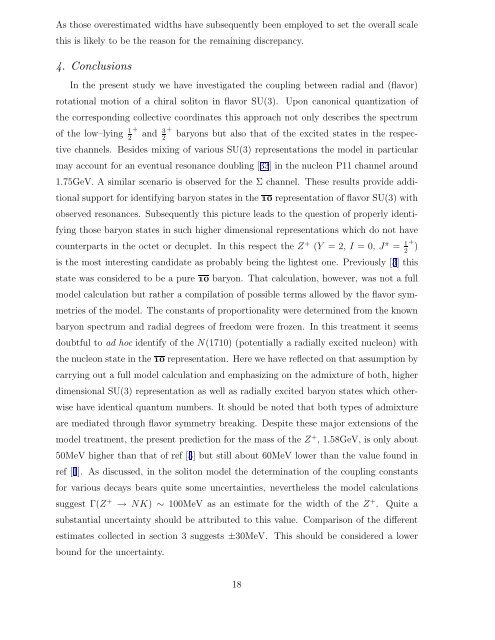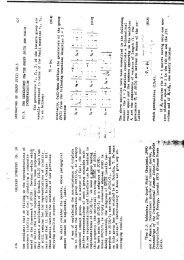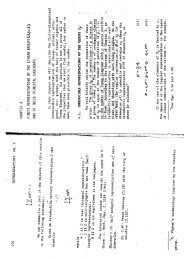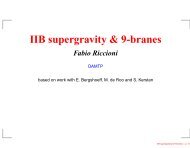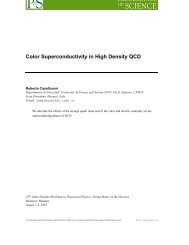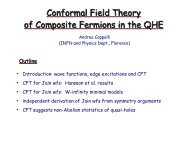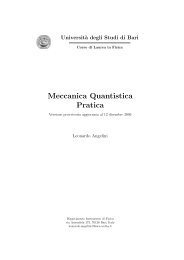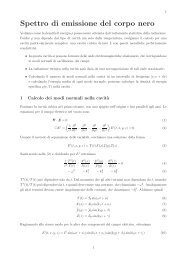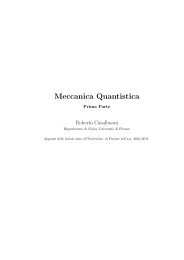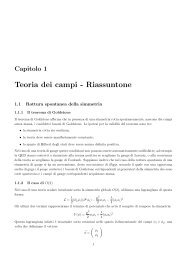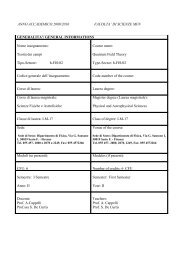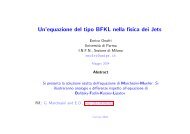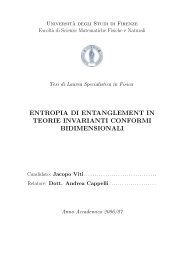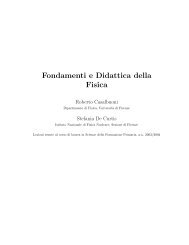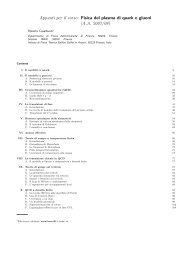arXiv:hep-ph/9804260 v2 16 Jun 1998 - Florence Theory Group
arXiv:hep-ph/9804260 v2 16 Jun 1998 - Florence Theory Group
arXiv:hep-ph/9804260 v2 16 Jun 1998 - Florence Theory Group
Create successful ePaper yourself
Turn your PDF publications into a flip-book with our unique Google optimized e-Paper software.
As those overestimated widths have subsequently been employed to set the overall scale<br />
this is likely to be the reason for the remaining discrepancy.<br />
4. Conclusions<br />
In the present study we have investigated the coupling between radial and (flavor)<br />
rotational motion of a chiral soliton in flavor SU(3). Upon canonical quantization of<br />
the corresponding collective coordinates this approach not only describes the spectrum<br />
of the low–lying 1+<br />
3+<br />
and baryons but also that of the excited states in the respec-<br />
2 2<br />
tive channels. Besides mixing of various SU(3) representations the model in particular<br />
may account for an eventual resonance doubling [33] in the nucleon P11 channel around<br />
1.75GeV. A similar scenario is observed for the Σ channel. These results provide addi-<br />
tional support for identifying baryon states in the 10 representation of flavor SU(3) with<br />
observed resonances. Subsequently this picture leads to the question of properly identi-<br />
fying those baryon states in such higher dimensional representations which do not have<br />
counterparts in the octet or decuplet. In this respect the Z + (Y = 2, I = 0, Jπ = 1+<br />
) 2<br />
is the most interesting candidate as probably being the lightest one. Previously [3] this<br />
state was considered to be a pure 10 baryon. That calculation, however, was not a full<br />
model calculation but rather a compilation of possible terms allowed by the flavor sym-<br />
metries of the model. The constants of proportionality were determined from the known<br />
baryon spectrum and radial degrees of freedom were frozen. In this treatment it seems<br />
doubtful to ad hoc identify of the N(1710) (potentially a radially excited nucleon) with<br />
the nucleon state in the 10 representation. Here we have reflected on that assumption by<br />
carrying out a full model calculation and em<strong>ph</strong>asizing on the admixture of both, higher<br />
dimensional SU(3) representation as well as radially excited baryon states which other-<br />
wise have identical quantum numbers. It should be noted that both types of admixture<br />
are mediated through flavor symmetry breaking. Despite these major extensions of the<br />
model treatment, the present prediction for the mass of the Z + , 1.58GeV, is only about<br />
50MeV higher than that of ref [3] but still about 60MeV lower than the value found in<br />
ref [1]. As discussed, in the soliton model the determination of the coupling constants<br />
for various decays bears quite some uncertainties, nevertheless the model calculations<br />
suggest Γ(Z + → NK) ∼ 100MeV as an estimate for the width of the Z + . Quite a<br />
substantial uncertainty should be attributed to this value. Comparison of the different<br />
estimates collected in section 3 suggests ±30MeV. This should be considered a lower<br />
bound for the uncertainty.<br />
18


